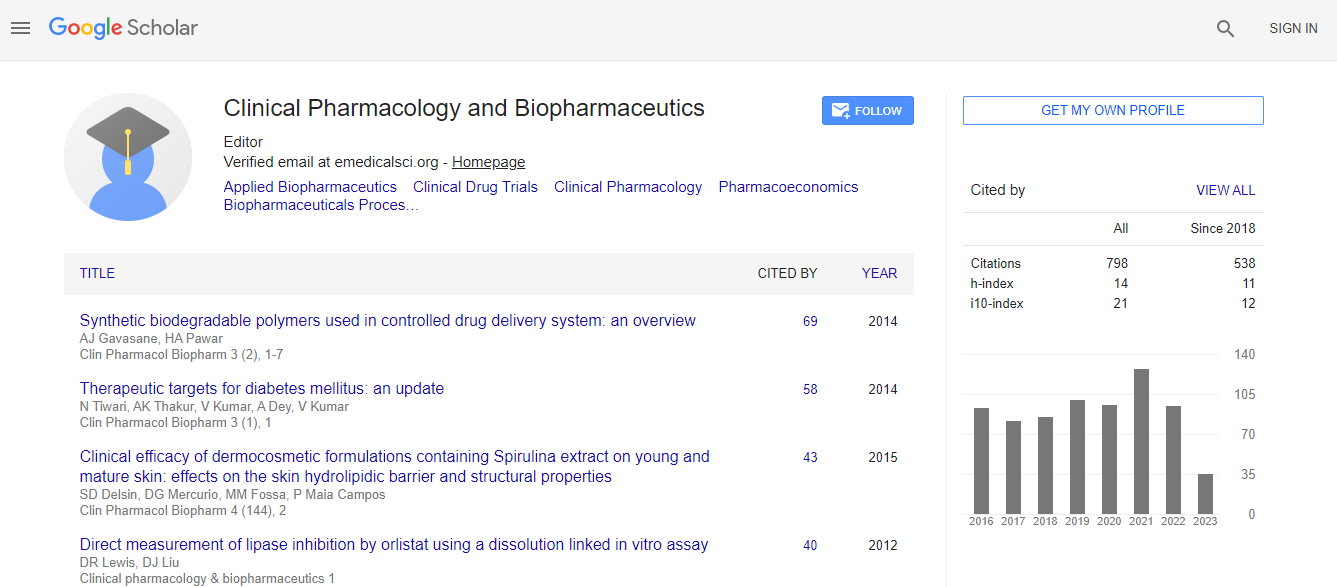Our Group organises 3000+ Global Conferenceseries Events every year across USA, Europe & Asia with support from 1000 more scientific Societies and Publishes 700+ Open Access Journals which contains over 50000 eminent personalities, reputed scientists as editorial board members.
Open Access Journals gaining more Readers and Citations
700 Journals and 15,000,000 Readers Each Journal is getting 25,000+ Readers
Google Scholar citation report
Citations : 1089
Clinical Pharmacology & Biopharmaceutics received 1089 citations as per Google Scholar report
Clinical Pharmacology & Biopharmaceutics peer review process verified at publons
Indexed In
- CAS Source Index (CASSI)
- Index Copernicus
- Google Scholar
- Sherpa Romeo
- Genamics JournalSeek
- RefSeek
- Hamdard University
- EBSCO A-Z
- OCLC- WorldCat
- Publons
- Euro Pub
- ICMJE
Useful Links
Recommended Journals
Related Subjects
Share This Page
Graphene oxide and gold nanorods conjugates for controlled release of doxorubicin by using 808 nm laser
International Conference and Expo on Biopharmaceutics
M Shahnawaz Khan1, Sunil Pandey3, Mukesh Lavkush Bhaisare3, Mukeshchand Thakur1 and Hui-Fen Wu1, 2, 3
1National Sun Yat-Sen University and Academia Sinica, Taiwan 2Kaohsiung Medical University, Taiwan 3National Sun Yat-Sen University, Taiwan
ScientificTracks Abstracts: Clin Pharmacol Biopharm
Abstract
Graphene Oxide (GO), a close derivative of graphene has unlocked many pivotal steps in drug delivery due to their inherent biocompatibility, heavy drug loading capacity and high aqueous solubility. We used a novel plant material called Gum Arabic (GA) to increase the solubility of GO as well as to chemically reduce it in the solution. GA functionalized GO (fGO) exhibited increased absorption in Near Infra-Red Region (NIR) which was exploited in photothermal therapy for cancer. To augment the shape and size related problems of GO (which in turn affect their rheological properties), we have conjugated them with gold nanorods (GNRs) using in situ synthesis of GO and GNRs via seed mediated method. To the above conjugate, Doxorubicin (DOX) was attached at ambient temperature (28�±2 �°C). Release kinetics of DOX with and without NIR exposure was also studied followed by in vitro photothermal killing of A549 cell lines. Enhanced NIR induced drug release as well photothermal property was observed which makes fGO@GNRs-DOX ideal for chemotherapy as well as photothermal therapy.Biography
M Shahnawaz Khan is currently a PhD student at Marine Biotechnology, National Sun Yat Sen University Kaohsiung, Taiwan. He did undergraduate in Honors Industrial Chemistry and masters in Industrial Chemistry from India’s prestigious university Aligarh M University, INDIA (2009). He is working on the hot topic like targeted drug delivery for curing cancer and employing photo-thermal method for releasing the drug at tumor region. He is concentrated on developing an effective method for wound control infection by using gold nanorods (Au NRs) and Nd-YAG laser (1064 nm) for photothermal killing Pseudomonas aeruginosa bacteria and simultaneously healing the wound infection on the (albino) mice. He is also curious to work on the brain diseases like Alzheimer, for it he synthesized the carbon nanodots and attached with Dopamine hydrochloride for efficient delivery to brain.
Email: hwu@faculty.nsysu.edu.tw

 Spanish
Spanish  Chinese
Chinese  Russian
Russian  German
German  French
French  Japanese
Japanese  Portuguese
Portuguese  Hindi
Hindi 
